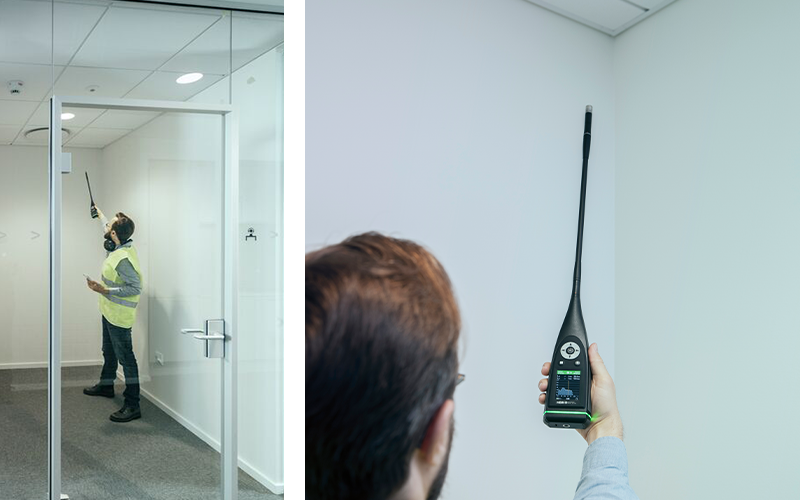
Low-frequency noise? We’ve got it cornered
Annoyance from low-frequency noise is increasingly recognized as a problem in multi-family residential buildings. Unfortunately, low-frequency sound insulation is difficult to determine accurately, particularly in smaller rooms such as bedrooms – precisely the kinds of rooms where low-frequency noise is most likely to cause annoyance.
To address this need, ISO 16283 introduced additional procedures for sound insulation measurements below 100 Hz where the source or receiver rooms are smaller than 25 m3. These new procedures are performed in addition to the standard measurements and are used to adjust bands below 100 Hz in sound insulation calculations.
For level measurements, the low-frequency procedure requires additional measurements in four corners of the room, two of which should be at floor level and the other two at ceiling level. The highest level in any corner is then determined for each frequency band and combined with the average levels from the standard procedure in a weighted average. The background correction for level measurements in the receiving room is also different to the standard procedure, with background measurements made in each corner and used to individually correct the corresponding corner level measurement.
For an airborne partition where both the source and receiving rooms are smaller than 25 m3, the low-frequency procedure requires 20 additional level measurement positions.
Combined with the requirements to treat each band separately, and to individually correct receiving room levels for background noise, the low-frequency procedure adds substantial bookkeeping to a project. Thankfully, Building Acoustics Partner handles all this bookkeeping for the user. The procedure is automatically triggered when needed, and intelligently integrated into the standard workflow. HBK 2255’s rigid microphone extension rod also makes it easy and safe to measure in room corners.
When the receiving room is smaller than 25 m3, there is also a low-frequency procedure for reverberation time measurements. The low-frequency reverberation time procedure requires that the 63 Hz 1/1-octave band is measured instead of the 50 Hz, 63 Hz and 80 Hz 1/3-octave bands. This single 1/1-octave band reverberation time is used instead of the 1/3-octave band values in the calculation of DnT and/or R'. The requirements for source and microphone positions are the same as for the standard reverberation time measurements.
HBK 2255 and Building Acoustics Partner implements the
low-frequency procedure for reverberation time without any extra effort from the user. Instead of measuring all reverberation time positions separately for 1/1- and 1/3-octave bandwidths,
HBK 2255 can measure reverberation time for both bandwidths simultaneously, halving the number of reverberation time measurements needed. The app automatically replaces the 50 Hz, 63 Hz and 80 Hz 1/3-octave reverberation time values with the 63 Hz 1/1-octave reverberation time when required.
The low-frequency procedure in ISO 16283 undoubtedly improves the reliability of low-frequency sound insulation measurements in small rooms but adds substantial complexity to the measurement procedure, bookkeeping and calculations.
HBK 2255 and Building Acoustics Partner allow users to gain the benefits of this method in the simplest and most efficient way possible.
Watch the HBK 2255 demo

